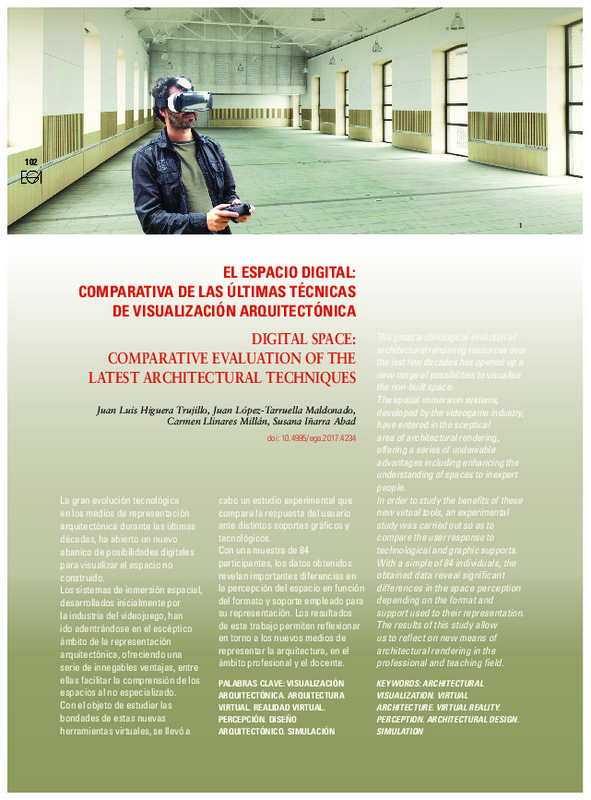JavaScript is disabled for your browser. Some features of this site may not work without it.
Buscar en RiuNet
Listar
Mi cuenta
Estadísticas
Ayuda RiuNet
Admin. UPV
El espacio digital: comparativa de las últimas técnicas de visualización arquitectónica
Mostrar el registro sencillo del ítem
Ficheros en el ítem
| dc.contributor.author | Higuera-Trujillo, Juan Luis
|
es_ES |
| dc.contributor.author | López-Tarruella Maldonado, Juan
|
es_ES |
| dc.contributor.author | Llinares Millán, Carmen
|
es_ES |
| dc.contributor.author | Iñarra Abad, Susana
|
es_ES |
| dc.date.accessioned | 2017-11-23T13:01:34Z | |
| dc.date.available | 2017-11-23T13:01:34Z | |
| dc.date.issued | 2017-11-21 | |
| dc.identifier.issn | 1133-6137 | |
| dc.identifier.uri | http://hdl.handle.net/10251/91405 | |
| dc.description.abstract | [EN] The great technological evolution of architectural rendering resources over the last few decades has opened up a new range of possibilities to visualise the non-built space.The spatial immersion systems, developed by the videogame industry, have entered in the sceptical area of architectural rendering, offering a series of undeniable advantages including enhancing the understanding of spaces to inexpert people.In order to study the benefits of these new virtual tools, an experimental study was carried out so as to compare the user response to technological and graphic supports.With a simple of 84 individuals, the obtained data reveal significant differences in the space perception depending on the format and support used to their representation. The results of this study allow us to reflect on new means of architectural rendering in the professional and teaching field. | es_ES |
| dc.description.abstract | [ES] La gran evolución tecnológica en los medios de representación arquitectónica durante las últimas décadas, ha abierto un nuevo abanico de posibilidades digitales para visualizar el espacio no construido. Los sistemas de inmersión espacial, desarrollados inicialmente por la industria del videojuego, han ido adentrándose en el escéptico ámbito de la representación arquitectónica, ofreciendo una serie de innegables ventajas, entre ellas facilitar la comprensión de los espacios al no especializado. Con el objeto de estudiar las bondades de estas nuevas herramientas virtuales, se llevó a cabo un estudio experimental que compara la respuesta del usuario ante distintos soportes gráficos y tecnológicos. Con una muestra de 84 participantes, los datos obtenidos revelan importantes diferencias en la percepción del espacio en función del formato y soporte empleado para su representación. Los resultados de este trabajo permiten reflexionar en torno a los nuevos medios de representar la arquitectura, en el ámbito profesional y el docente. | es_ES |
| dc.description.sponsorship | Este trabajo de investigación ha sido financiado por el Ministerio de Economía y Competitividad de España (proyecto TIN2013-45736-R). | |
| dc.language | Español | es_ES |
| dc.language | Inglés | es_ES |
| dc.publisher | Universitat Politècnica de València | |
| dc.relation.ispartof | EGA. Revista de Expresión Gráfica Arquitectónica | |
| dc.rights | Reserva de todos los derechos | es_ES |
| dc.subject | Visualización arquitectónica | es_ES |
| dc.subject | Arquitectura virtual | es_ES |
| dc.subject | Realidad virtual | es_ES |
| dc.subject | Percepción | es_ES |
| dc.subject | Diseño arquitectónico | es_ES |
| dc.subject | Simulación | es_ES |
| dc.subject | Architectural visualization | es_ES |
| dc.subject | Virtual architecture | es_ES |
| dc.subject | Virtual reality | es_ES |
| dc.subject | Perception | es_ES |
| dc.subject | Architectural design | es_ES |
| dc.subject | Simulation | es_ES |
| dc.title | El espacio digital: comparativa de las últimas técnicas de visualización arquitectónica | es_ES |
| dc.title.alternative | Digital space: comparative evaluation of the latest architectural techniques | es_ES |
| dc.type | Artículo | es_ES |
| dc.date.updated | 2017-11-23T08:17:57Z | |
| dc.identifier.doi | 10.4995/ega.2017.4234 | |
| dc.relation.projectID | info:eu-repo/grantAgreement/MINECO//TIN2013-45736-R/ES/INVESTIGACION DE NUEVAS METRICAS DE NEUROARQUITECTURA MEDIANTE EL USO DE ENTORNOS VIRTUALES INMERSIVOS/ | |
| dc.rights.accessRights | Abierto | es_ES |
| dc.contributor.affiliation | Universitat Politècnica de València. Departamento de Expresión Gráfica Arquitectónica - Departament d'Expressió Gràfica Arquitectònica | es_ES |
| dc.contributor.affiliation | Universitat Politècnica de València. Instituto Interuniversitario de Investigación en Bioingeniería y Tecnología Orientada al Ser Humano - Institut Interuniversitari d'Investigació en Bioenginyeria i Tecnologia Orientada a l'Ésser Humà | es_ES |
| dc.contributor.affiliation | Universitat Politècnica de València. Escuela Técnica Superior de Arquitectura - Escola Tècnica Superior d'Arquitectura | es_ES |
| dc.description.bibliographicCitation | Higuera-Trujillo, JL.; López-Tarruella Maldonado, J.; Llinares Millán, C.; Iñarra Abad, S. (2017). El espacio digital: comparativa de las últimas técnicas de visualización arquitectónica. EGA. Revista de Expresión Gráfica Arquitectónica. 22(31):102-111. https://doi.org/10.4995/ega.2017.4234 | es_ES |
| dc.description.accrualMethod | SWORD | es_ES |
| dc.relation.publisherversion | https://doi.org/10.4995/ega.2017.4234 | es_ES |
| dc.description.upvformatpinicio | 102 | es_ES |
| dc.description.upvformatpfin | 111 | es_ES |
| dc.type.version | info:eu-repo/semantics/publishedVersion | es_ES |
| dc.description.volume | 22 | |
| dc.description.issue | 31 | |
| dc.identifier.eissn | 2254-6103 | |
| dc.contributor.funder | Ministerio de Economía y Competitividad |








